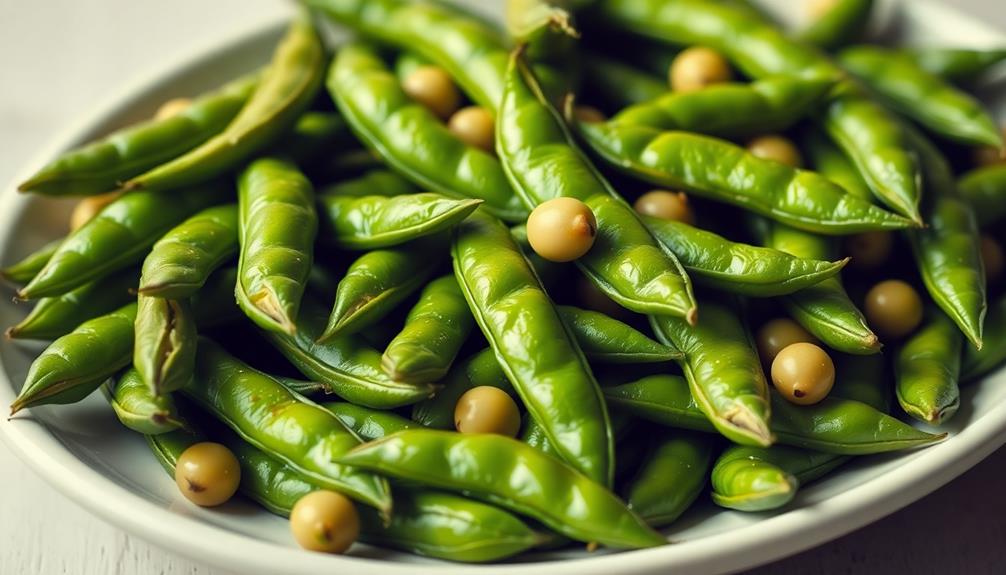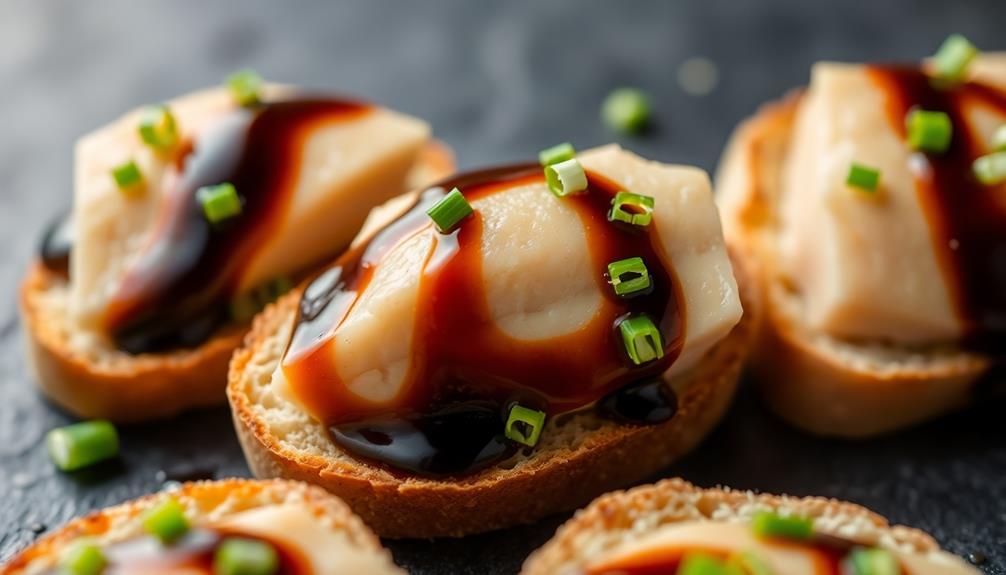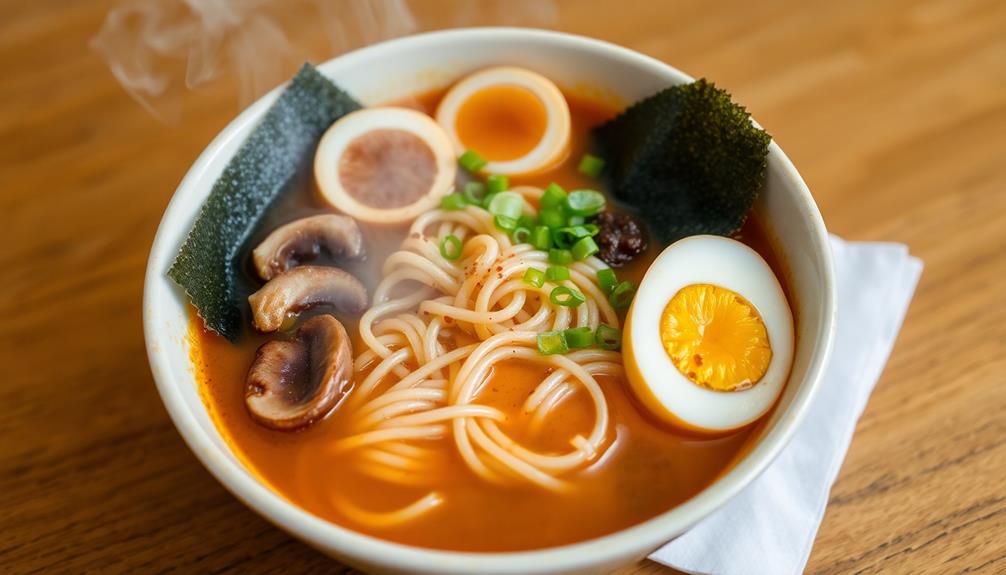You're probably familiar with edamame, but did you know this vibrant green snack has a rich history dating back to ancient China? Today, it's a staple in Japanese cuisine and a popular choice worldwide, especially in the United States. Whether you enjoy it steamed and lightly salted or with tasty seasonings, there's more to this versatile legume than meets the eye. As you'll soon discover, edamame is not just delicious – it's also packed with protein, making it a healthy addition to any meal or appetizer spread.
Key Takeaways
- Edamame originated in ancient China and has been a staple in Japanese cuisine since the 8th century.
- Edamame is a protein-rich snack that gained global popularity in the late 20th century.
- Typical preparation involves boiling fresh edamame pods in salted water for 3-7 minutes.
- Seasoning options for cooked edamame include salt, lemon juice, and soy sauce.
- Edamame is best served immediately while hot, with the pods popped open for the beans.
History
Although the origins of edamame aren't entirely clear, evidence suggests that this snack food has been consumed in Asia for centuries. Believed to have first emerged in ancient China, edamame, or boiled and salted immature soybeans, became a staple in Japanese cuisine as early as the 8th century.
Over time, the popularity of edamame spread to other parts of Asia, including Korea and Taiwan.
In the late 20th century, edamame gained global recognition as a healthy, protein-rich snack. Today, it's enjoyed worldwide, particularly in the United States, where it has become a beloved appetizer and side dish.
The versatility of edamame allows it to be served in a variety of preparations, from simple boiled and salted versions to more elaborate dishes featuring the flavorful beans.
Whether savored as a quick snack or incorporated into a larger meal, edamame continues to captivate taste buds and showcase the rich culinary heritage of Asia.
Recipe
Edamame, the beloved Japanese appetizer, is a simple yet delightful snack that can be enjoyed year-round. The tender, slightly salted soybeans offer a tasty and nutritious way to start a meal or satisfy a craving.
To prepare edamame at home, you'll find that the process is straightforward and requires minimal effort. Whether you're hosting a gathering or simply craving a healthy snack, this recipe will guide you through the steps to achieve perfectly cooked edamame every time.
- 1 pound fresh edamame in the pod
- 1 tablespoon kosher salt
- 4 cups water
Bring the water to a boil in a large pot. Add the kosher salt and the edamame pods. Cook for 5-7 minutes, or until the pods are bright green and the beans are tender. Drain the edamame and serve immediately, providing a small bowl for discarding the empty pods.
When cooking edamame, it's important to avoid overcooking, as this can result in a mushy texture. Additionally, be mindful of the salt content, as the edamame can become overly salty if left in the boiling water for too long.
Serve the edamame warm, with a sprinkle of additional salt if desired, and enjoy this delightful Japanese snack.
Cooking Steps
Bring a pot of water to a boil, then add a pinch of salt.
Carefully drop the edamame into the boiling water and let them cook for a few minutes.
Once they're tender, drain the edamame using a colander and serve them immediately while they're hot and flavorful.
Step 1. Bring Water to a Boil
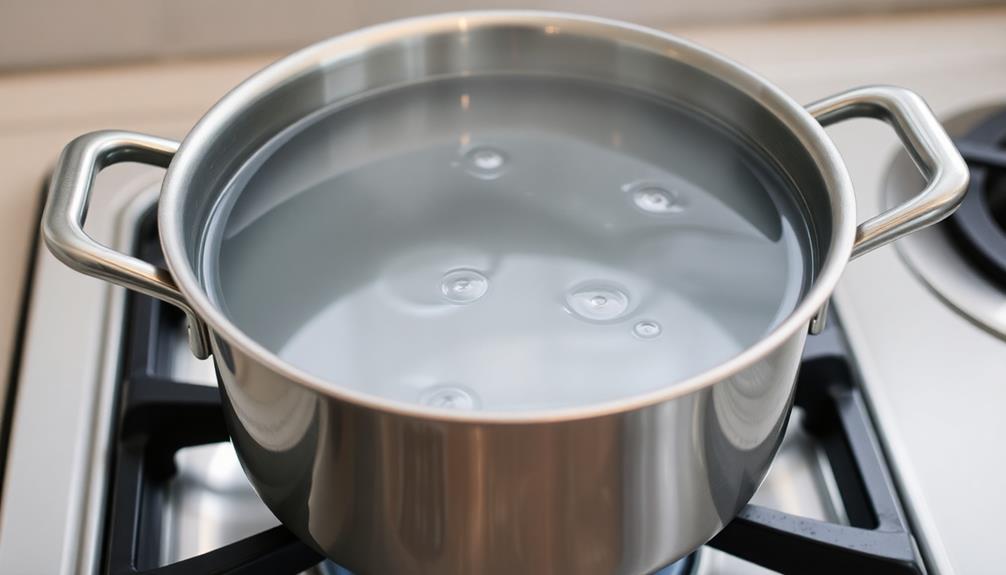
To begin, you'll want to bring a pot of water up to a rolling boil. This is the crucial first step in preparing delicious edamame. Fill a medium-sized pot with enough water to submerge the edamame pods. Place the pot on the stove over high heat. Keep a close eye on the water, as it shouldn't take long to reach a vigorous boil.
Once the water is rapidly bubbling, you're ready for the next step.
Next, carefully add the edamame pods to the boiling water. Gently lower them in using a slotted spoon or tongs to avoid splashing. Let the edamame cook for 3-5 minutes, until they're tender and bright green. Be sure to stir the pods occasionally for even cooking.
When the time is up, quickly drain the edamame in a colander. Run them under cold water to stop the cooking process and preserve their vibrant color. Now your edamame is ready to season and serve!
Step 2. Add Salt to Water

Add a pinch of salt to the boiling water before adding the edamame pods. The salt helps to season the edamame, enhancing their natural flavor.
It also helps the pods retain their vibrant green color during the cooking process. Stir the salt into the water until it has fully dissolved, ensuring an even distribution.
Once the water is seasoned, carefully add the edamame pods. Bring the water back to a boil and let the pods cook for 3-5 minutes, or until they're tender but still slightly crunchy.
Be careful not to overcook, as this can make the edamame taste mushy.
Drain the cooked edamame in a colander and serve them warm, either on their own as a snack or as a flavorful side dish.
The salt added to the water creates the perfect balance of savory and fresh, making the edamame irresistible.
Step 3. Add Edamame to Boiling Water
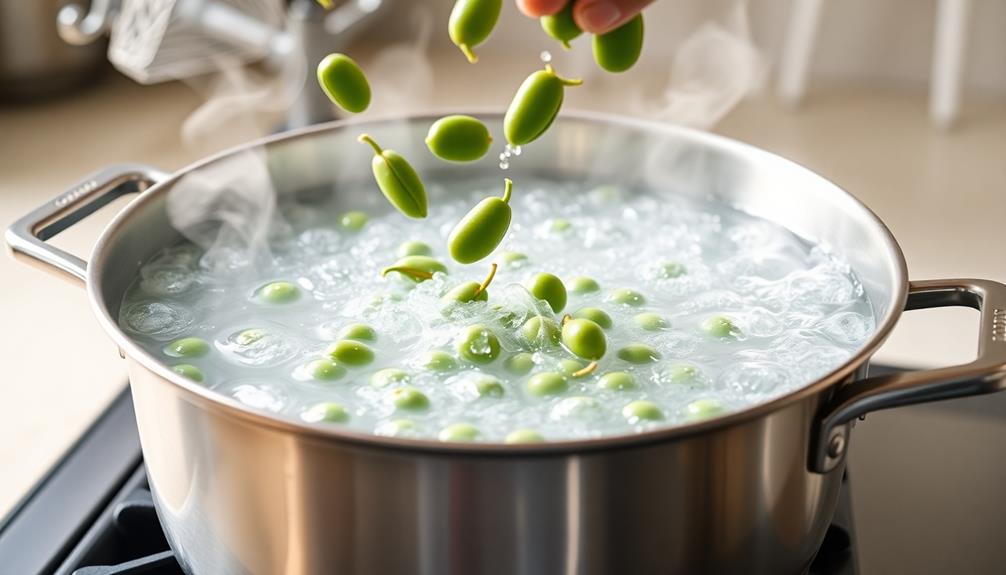
Once you've seasoned the water with salt, you're ready to add the edamame. Carefully pour the frozen edamame into the boiling water. The edamame will immediately start to cook, releasing their vibrant green color.
Set a timer for 5-6 minutes, allowing the edamame to simmer until they're tender and bright.
Carefully drain the edamame in a colander, making sure to remove any excess water. Transfer the cooked edamame to a serving bowl.
At this point, you can choose to season them further with a sprinkle of additional salt, a squeeze of lemon juice, or a drizzle of soy sauce. The warm, salty-sweet flavor of the edamame pairs perfectly with these simple seasonings.
Serve the edamame warm, encouraging your guests to pop the tender beans directly from the pod into their mouths. Enjoy this healthy and delightful snack as you gather with friends and family.
Step 4. Drain Edamame Using Colander
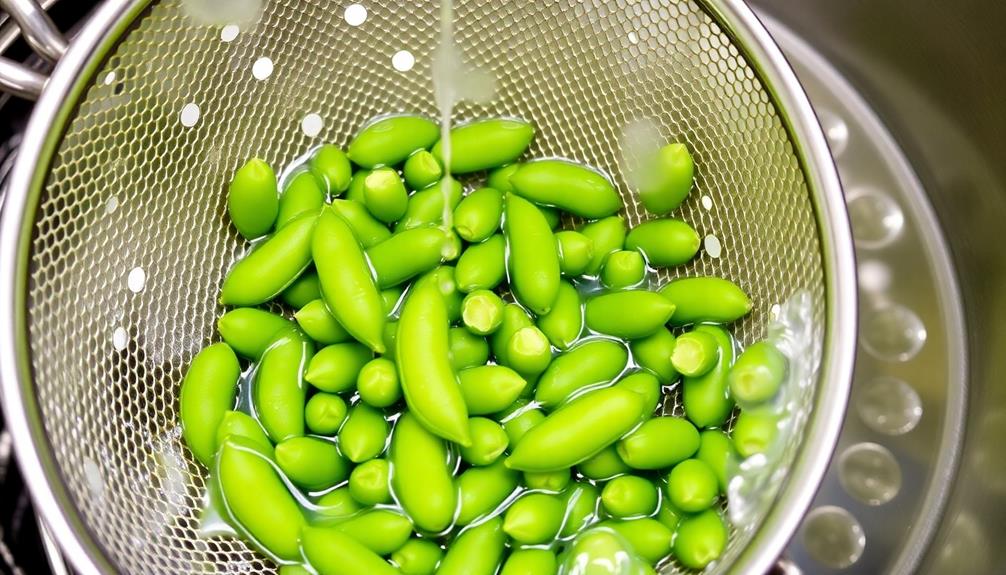
Carefully drain the cooked edamame in a colander, ensuring to remove any excess water.
Hold the colander over the sink and gently shake it to help the edamame drain thoroughly. You can also use your hands to lightly toss the edamame in the colander, allowing the water to drip off.
Once the edamame are well-drained, transfer them to a serving bowl or plate. If you plan to season the edamame, this is the perfect time to do so.
Consider sprinkling them with a bit of salt, lemon juice, or your favorite seasonings to enhance the flavor. The drained edamame are now ready to be enjoyed as a tasty snack or side dish.
Remember to handle the hot colander with care, as the edamame and water may still be quite warm.
Take your time and be mindful of the temperature to avoid any accidental burns. Enjoy your freshly prepared edamame!
Step 5. Serve Immediately While Hot
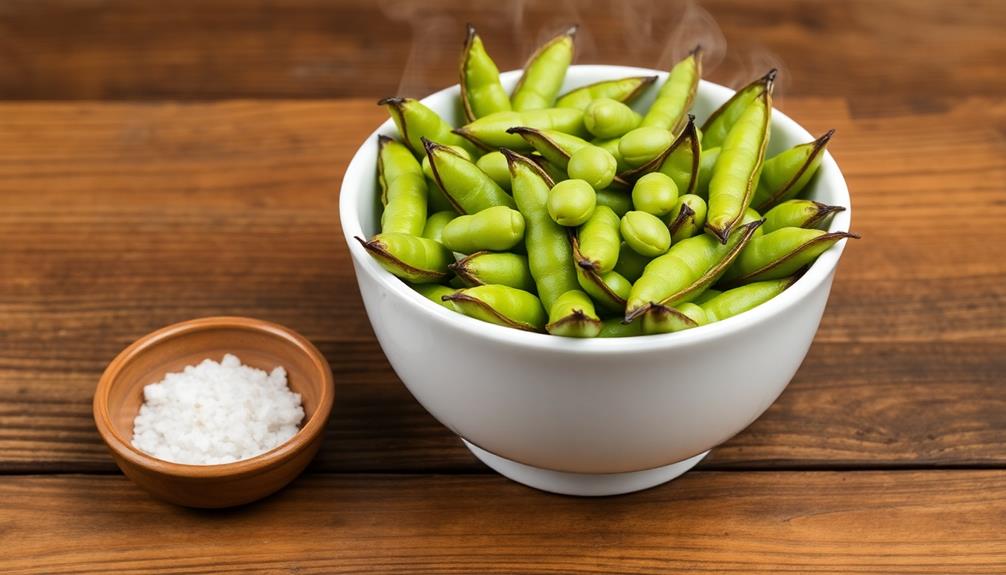
The freshly drained edamame are now ready to be served. You'll want to serve them immediately while they're still piping hot. If you’re looking for a simple yet delicious accompaniment, consider boiling up some traditional udon noodles to serve alongside the edamame. The combination of the tender, slightly sweet edamame with the chewy, hearty udon noodles is a classic pairing in Japanese cuisine. The contrast in textures and flavors makes for a satisfying and comforting dish.
Grab a large serving bowl and carefully transfer the edamame into it. The vibrant green pods will be steaming, releasing that delightful nutty aroma.
Sprinkle some coarse sea salt over the top – the salty crunch pairs perfectly with the tender edamame. If you're feeling adventurous, try experimenting with other seasonings like garlic powder, chili lime seasoning, or even a drizzle of toasted sesame oil. However, don't overpower the natural flavors. The true joy of edamame is in its simple, fresh taste.
Gather your friends and family around the table, provide small bowls for the discarded pods, and enjoy popping open each pod straight from the steaming bowl. It's a fun, interactive way to share this tasty snack.
Don't let the edamame sit for too long – they're best savored immediately while hot.
Final Thoughts
Edamame is a popular snack that can be enjoyed in various ways. As you've learned, properly preparing and serving edamame is key to maximizing its deliciousness.
Whether you choose to boil, steam, or microwave the pods, the final result should be hot, vibrant, and bursting with flavor.
Don't be afraid to get creative with seasonings and dipping sauces. A sprinkle of sea salt, a drizzle of sesame oil, or a splash of soy sauce can take your edamame experience to new heights.
And remember, the key to enjoying edamame is to dive in while it's hot, savoring each bite straight from the pod.
